|
Shalimar - Digha - Santragachhi - Howrah
Saurab and I had decided Digha would be our next port of call. The last stretch of the section, from Kanthi to
Digha had been inaugurated on the last day of December 2004, finally connecting Kolkata to the popular seaside
destination.
So far, there is a single express service connecting the two cities. The 8027/28 Shalimar-Digha Express starts
its journey from the South Eastern Railway terminus at Shalimar, south of Howrah, which is primarily a goods terminus.
Apart from this, only one other express is handled here.
We started off well in time for the 0755 departure one fine January morning. Crossing over the new Hooghly Bridge,
we took the left turn towards Shalimar and then had some trouble finding our way. There were some signage, but
not adequate. And we finally spotted the train at the station. We found a ticket booking office, only to be told
that the tickets for that particular train are sold at a counter on the other side of the tracks. We purchased
the II class ordinary tickets, costing Rs 57 each for the 186 km journey (Digha - Howrah is 189 km), and went back
to the platform.
The station itself has a solitary island platform, with track son either side. An unique feature is the funnel
shaped platform roofing, where the rainwater collects at the tip of the full and is drained out by pipes enclosed
within the concrete pillars. I wonder is the water is collected and used. Apart from our train, there were a few
goods rakes at the station, with little movement.
The seven-coach rake was already at the platform. It was air-braked, and consisted of 2 SLRs, 3 unreserved second
class coaches and 2 reserved second class coaches. The unreserved coaches had wooden (but not slatted) seats in
the 5+1 formation. We boarded the one closest to the engine and parked ourselves. The coach was empty till then.
There were a few passengers lolling around and the cup of tea we had was very welcome. Thereupon it started filling
up somewhat. A Kharagpur shed WDM2 18553R, long hood forward (which I was glad for, since it would mean we would
be short hood forward on the way back) was at the head. At 0759, we pulled out.
The route from Shalimar to Santragachhi Jn (where we joined the Howrah - Kharagpur main lines) was double lined,
but only one track was electrified. After the stoppage at Santragachhi, where the Bhubaneshwar bound Jan Shatabdi
crossed us, we picked up good speed, touching about 110 kmh. Beyond Santragachhi, it was triple tracked.
Soon after Abada, we crossed the down Mumbai - Howrah Mail, with a shiny WAP-4 in charge. It had a bright red RMS
coach and surprisingly, the last coach was of the maroon VB livery. We crossed the Damodar river and then the Rupnarayan
at Kolaghat, and soon after Mecheda (where there was a short stop), we turned out at Panskura East Outer to join
the Panskura - Haldia line. From here it was a single electrified track. We had no crossings on the way, as we
moved at a steady 70-75 kph, reaching the next stop at Tamluk. Just after Tamluk is the Tamluk Jn Cabin, where
the line to Digha diverges from the Haldia line. We passed this, turning to the right to take the Digha line. I
was surprised to see that electrification masts were already up along much of the route. We sped along, touching
the maximum of 80, slowing down to cross the bridge over the Haldi river, and picking up speed again till we reached
Kanthi. Since this was an express, we didn't stop at the smaller stations, which we passed at speed. An unique
feature was that at most stations, there was no provision for crossings, and the platform is on the loop line,
which has been made operational. The straight through tracks were mostly under construction. Tamluk - Digha station
operates under the "one train only" system, and there is no signaling. The only other service in this
area is the DMU, which runs between Digha and Panskura. Some of the level crossings along the way did not have
staff, so the train carried a gateman. At such crossings, the train would stop just before the crossing, the gateman
would jump off and lock the gates and the train would then pass, stopping again to pick up the gateman.
The region had lush green fields, and some construction. There were villages along the way, but no big settlements.
The stations were not yet fully ready, wit earthwork in progress in quite a few of them. The train was still a
novelty here; with people queuing up to watch us zip past. Cows and goats, which sedately graze in other places
as trains pass by, could be seen scrambling away in fear as we passed them.
There was a special checking on board. A group of about 3-4 ticket examiners came and checked our tickets. They
must have changed coaches at stations since there was no vestibule as far as I could see. At one of the level crossing
stops, a huge bunch of local folk boarded our coach, in spite of repeated warnings from us that there was a ticket
checking drive on. Soon after the TTEs descended upon them They insisted they did not have money with them after
being told to cough up large amounts as penalty. The women were warned that there would be lady police officers
at Digha who could, if necessary, carry out a search. I don't know what happened to them for we reached Digha at
noon and got down, ten minutes before schedule.
The station of Digha is situated at New Digha, and has two platforms. The station building, in white, is at the
end of the line. We watched as the engine was decoupled. A pointsman was manually changing the track and I saw
him clamp the tracks together with a vice. Now I wonder whether that was because the new turnout mechanism was
still not greased enough, or was it some rudimentary form of interlocking. We booked our return tickets (to Howrah)
and then made our way outside, which was filled with cycle rickshaw vans, offering to take us anywhere we cared.
There was not much else there.
We decided to walk to the beach, which was about a kilometer away. There was a sizeable crowd there, fear of tsunamis
notwithstanding. People were busy enjoying their little break. We decided to grab a bite, haven't eaten anything
since morning. We found a small restaurant, where we had fish and rice. I found some of the dishes surprisingly
expensive. The fish fry was palatable enough, even though the waiter got me Pepsi instead of the regulation Thums
Up. Having had our fill, we had to head back to the station, as the train was due to depart at 1430.
There was a sizeable crowd at the station and the coaches were already filled. I heard the ticket clerk informing
passengers there was no reservation available either for that day or the next. We walked to the engine, and came
across other curious onlookers too. We made our way to the first coach, which was full up, and we had to stand
at the door. The train started off as we stood and chatted, and soon we were at Kanthi once again, where we managed
to get into the engine. The friendly crew entertained our questions. I had been in a WDM2 cab after a long time
and was shocked to notice there were no fans. Also, the seats were hard wooden ones, with no padding. The doors
leading to the walkways did not have enough rubber padding, letting cold air in at night.
The engine itself seemed to be in a reasonable condition, especially when it did not make enough smoke when it
was required, somewhat disappointing the photographer in me.
We sped along. Chatting with the assistant, we found that the following were the maximun permissible speeds along
our route:
- Santragachhi - Panskura East Outer: 105 kph
- Panskura East Outer - Tamluk Jn Cabin: 75 kph
- Tamluk Jn Cabin - Kanthi: 80 kph
- Kanthi - Digha: 60 kph
The last section had a low speed since it was a very new one. In addition there
were caution orders for the Haldi bridge, as well as for quite a few level crossings. We reached Tamluk before
time, enabling us to spend a few minutes on the foot overbridge and take photographs. Back on the loco, we made
our way towards Kolkata. We were at the max permissible speed and made good time, Pulling into Panskura just a
minute late. By then it was dark, and I noticed that the speedometer at the driver's side did not have its light
working which prompted the driver to continuously shine his torch on the display to take a speed reading.
At Panskura, we were handed a fresh caution order, which the assistant indicated meant that we would be taking
the flyover to reach Santragachhi. He did explain to me what it implied but I am a little confused about that.
Essentially what happens is that in that region around antragachhi, the line towards Dankuni and Amta also branch
out, an dthere is a series of connecting lines. Santragachhi itself has its up an down lines separated by the locosheds
(there is a diesel trip shed here, previously unknown to me), and to enable a train to get onto the correct platform
and proceed towards Shalimar, its often required to use the flyover. This is dictated by the track situation, and
which line is blocked.
I hardly even noticed that we were on the flyover. It was dark already and we made our way to Santragachhi by about
7 pm. We were too tired to keep vigil by then, feet hurting by the continuous vibrations of the loco. We bid goodbye
and changed platforms to take an EMU local to Howrah. The local was packed, as many from our train had changed
to the EMU at Santragachhi too. The last three stations whizzed past, and thankfully, without further ado, we got
into Howrah at about 8.20 pm.
After a hurried dinner of Hyderabadi Biriyani (which Saurab refused to partake), we went and got ourselves a taxi
to take us home, tired, but happy.
|
|
|
|
|
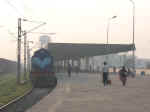
WDM #18553R at Shalimar station with the 8027/28 Shalimar-Digha Exp. Note the funnel
shaped platform roof.
|
|
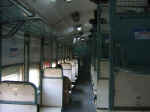
Interior of the II class coach.
|
|
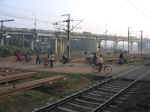
Santragachhi Jn, the lines veering off to the right (backgrond) are towards Howrah. The brige above carries the
Kona Expressway.
|
|
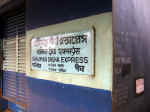
The name board of affixed to teh SLR coach.
|
|
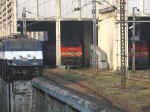
Passing shot of Santragachhi Electric Loco shed, with a blue liveried WAP-4 outside.
|
|
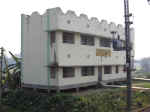
Tamluk Jn Cabin, from where the line towards Digha branches out from the Haldia line.
|
|
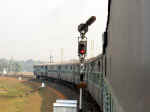
Signal guarding the Tanlunk Jn Cabin.
|
|
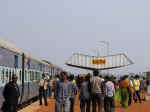
Kanthi station.
|
|
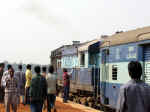
The driver inspects the loco as the others look on.
|
|
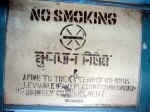
No-smoking sign stencilled on the coach interior.
|
|
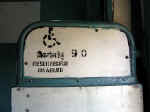
One seat is specifically reserved for the disabled.
|
|
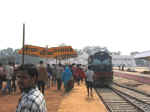
The station at Digha. The white building at the back houses all the railway offices.
|
|
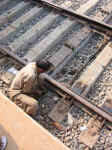
A pointsman using a clamp to secure the turnout at Digha.
|
|
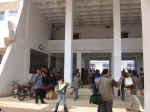
Digha station from outside.
|
|
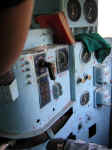
One of the control stands of the WDM-2
|
|
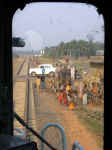
View from the cab. We look on as the train stop for the travelling gatesman to secure the gate.
|
|
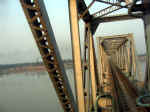
View form the cab of the bridge on the river Haldi
|
|
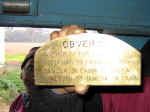
Right of Way... token issued on the single train only Tamluk Jn Cabin - Digha section.
|
|
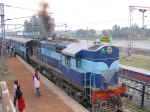
Our WDM2 attempting to make smoke at Tamluk station.
|
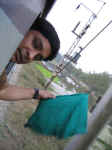
A tired but exhilarated me waves the green flag. |
|

